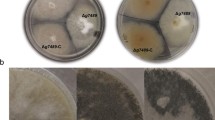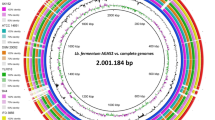Abstract
Eicosapentaenoic acid (EPA) belonged to the ω-3 series of polyunsaturated fatty acids and had physiological functions lipid as regulating blood lipid and preventing cardiovascular diseases. Schizochytrium sp. was considered to be a potential industrial fermentation strain of EPA because of its fast growth, high oil content, and simple fatty acid composition. However, Schizochytrium sp. produced EPA with low production efficiency and a long synthesis path. This research aims to improve the yield of EPA in Schizochytrium sp. by ARTP mutagenesis and to reveal the mechanism of high-yield EPA through transcriptome analysis. ARTP mutagenesis screening yielded the mutant M12 that whereas the productivity of EPA increased 108% reaching 0.48 g/L, the total fatty acid concentration was 13.82 g/L with an increase of 13.7%. The transcriptomics revealed 2995 differentially expressed genes were identified between M12 and the wild-type strain and transcripts involved in carbohydrate, amino acid, energy, and lipid metabolism were up-regulated. Among them, the hexokinase (HK) and the phosphofructokinase genes (PFK), which can catalyze pyruvate to acetyl-CoA, were increased 2.23-fold and 1.78-fold. Glucose-6-phosphate dehydrogenase (G6PD) and glutamate dehydrogenase (GLDH), which can both generate NADPH, were increased by 1.67-fold and 3.11-fold. Furthermore, in the EPA synthesis module, the expression of 3-oxoacyl-[acyl-carrier protein] reductase(fabG) and carbonyl reductase 4 / 3-oxoacyl-[acyl-carrier protein] reductase beta subunit(CBR4), also up-regulated 1.11-fold and 2.67-fold. These may lead to increases in cell growth. The results provide an important reference for further research on promoting fatty acid and EPA accumulation in Schizochytrium sp.









Similar content being viewed by others
Data availability
The datasets used and/or analyzed during the current study are available from the corresponding author on reasonable request.
References
Minhas AK, Hodgson P, Barrow CJ, Adholeya A (2016) A Review on the assessment of stress conditions for simultaneous production of microalgal lipids and carotenoids. Front Microbiol. https://doi.org/10.3389/fmicb.2016.00546
Xiao B, Li Y, Lin Y, Lin J, Zhang L, Wu D, Zeng J, Li J, Liu JW, Li G (2022) Eicosapentaenoic acid (EPA) exhibits antioxidant activity via mitochondrial modulation. Food Chem 373:131389
Ma W, Wang Y-Z, Nong F-T, Du F, Xu Y-S, Huang P-W, Sun X-M (2021) An emerging simple and effective approach to increase the productivity of thraustochytrids microbial lipids by regulating glycolysis process and triacylglycerols’ decomposition. Biotechnol Biofuels. https://doi.org/10.1186/s13068-021-02097-4
Okuda T, Ando A, Negoro H, Muratsubaki T, Kikukawa H, Sakamoto T, Sakuradani E, Shimizu S, Ogawa J (2015) Eicosapentaenoic acid (EPA) production by an oleaginous fungus Mortierella alpina expressing heterologous the Delta 17-desaturase gene under ordinary temperature. Eur J Lipid Sci Technol 117:1919–1927
Caamano E, Loperena L, Hinzpeter I, Pradel P, Gordillo F, Corsini G, Tello M, Lavin P, Gonzalez AR (2017) Isolation and molecular characterization of Thraustochytrium strain isolated from Antarctic Peninsula and its biotechnological potential in the production of fatty acids. Braz J Microbiol 48:671–679
Ratledge C (2004) Fatty acid biosynthesis in microorganisms being used for single cell oil production. Biochimie 86:807–815
Li D, Zhang K, Chen L, Ding M, Zhao M, Chen S (2017) Selection of Schizochytrium limacinum mutants based on butanol tolerance. Electron J Biotechnol 30:58–63
Wang Q, Chen Y, Fu J, Yang Q, Feng L (2020) High-throughput screening of lycopene-overproducing mutants of Blakeslea trispora by combining ARTP mutation with microtiter plate cultivation and transcriptional changes revealed by RNA-seq. Biochem Eng J 161:107664
Martinezalarcon D, Saborowski R, Harms L, Hagen W (2017) Transcriptome and gene expression analysis of the brown shrimp Crangon crangon reveals seasonal modulation of digestive enzymes
Wang K, Sun T, Cui J, Liu L, Bi Y, Pei G, Chen L, Zhang W (2018) Screening of chemical modulators for lipid accumulation in Schizochytrium sp S31. Biores Technol 260:124–129
Yu X-J, Sun J, Zheng J-Y, Sun Y-Q, Wang Z (2016) Metabolomics analysis reveals 6-benzylaminopurine as a stimulator for improving lipid and DHA accumulation of Aurantiochytriumsp. J Chem Technol Biotechnol 91:1199–1207
Jia Y-L, Geng S-S, Du F, Xu Y-S, Wang L-R, Sun X-M, Wang Q-Z, Li Q (2022) Progress of metabolic engineering for the production of eicosapentaenoic acid. Crit Rev Biotechnol 42:838–855
Liu L, Bai M, Zhang S, Li J, Liu X, Sen B, Wang G (2021) ARTP Mutagenesis of Schizochytrium sp. PKU#Mn4 and clethodim-based mutant screening for enhanced docosahexaenoic acid accumulation. Mar Drugs 19:564
Guo T, Tang Y, Xi Y-L, He A-Y, Sun B-J, Wu H, Liang D-F, Jiang M, Ouyang P-K (2011) Clostridium beijerinckii mutant obtained by atmospheric pressure glow discharge producing high proportions of butanol and solvent yields. Biotech Lett 33:2379–2383
Hua X, Wang J, Wu Z, Zhang H, Li H, Xing X, Liu Z (2010) A salt tolerant Enterobacter cloacae mutant for bioaugmentation of petroleum- and salt-contaminated soil. Biochem Eng J 49:201–206
Li X, Liu R, Li J, Chang M, Liu Y, Jin Q, Wang X (2015) Enhanced arachidonic acid production from Mortierella alpina combining atmospheric and room temperature plasma (ARTP) and diethyl sulfate treatments. Biores Technol 177:134–140
Fang M, Jin L, Zhang C, Tan Y, Jiang P, Ge N, Li H, Xing X (2013) Rapid mutation of spirulina platensis by a new mutagenesis system of Atmospheric and Room Temperature Plasmas (ARTP) and generation of a mutant library with diverse phenotypes. PLoS ONE 8:e77046
Ma Y, Yang H, Chen X, Sun B, Du G, Zhou Z, Song J, Fan Y, Shen W (2015) Significantly improving the yield of recombinant proteins in Bacillus subtilis by a novel powerful mutagenesis tool (ARTP): Alkaline alpha-amylase as a case study. Protein Express Purif 114:82–88
Wang Q, Feng LR, Wei L, Li HG, Wang L, Zhou Y, Yu XB (2014) Mutation breeding of lycopene-producing strain Blakeslea Trispora by a novel Atmospheric and Room Temperature Plasma (ARTP). Appl Biochem Biotechnol 174:452–460
Chen W, Zhou P-p, Zhang M, Zhu Y-m, Wang X-p, Luo X-a, Bao Z-d, Yu L-j (2016) Transcriptome analysis reveals that up-regulation of the fatty acid synthase gene promotes the accumulation of docosahexaenoic acid in Schizochytrium sp S056 when glycerol is used. Algal Res Biomass Biofuels Bioproducts 15:83–92
Liu J, Pei G, Diao J, Chen Z, Liu L, Chen L, Zhang W (2017) Screening and transcriptomic analysis of Crypthecodinium cohnii mutants with high growth and lipid content using the acetyl-CoA carboxylase inhibitor sethoxydim. Appl Microbiol Biotechnol 101:6179–6191
Sun X-M, Ren L-J, Ji X-J, Chen S-L, Guo D-S, Huang H (2016) Adaptive evolution of Schizochytrium sp by continuous high oxygen stimulations to enhance docosahexaenoic acid synthesis. Biores Technol 211:374–381
Huang CZ, Li YF, Feng P (2001) Determination of single-stranded DNA through its hybridization with complementary probes coupled on the surfaces of carboxylate polystyrene spheres. Anal Lett 34:1617–1625
Wang Q, Jin W, Han W, Song K, Chen Y, Chen C, Jiang G, Zhou X (2022) Enhancement of DHA production from Aurantiochytrium sp. by atmospheric and room temperature plasma mutagenesis aided with microbial microdroplet culture screening. Biomass Convers Biorefinery
Ren LJ, Hu XC, Zhao XY, Chen SL, Wu Y, Li D, Yu YD, Geng LJ, Ji XJ, Huang H (2017) Transcriptomic analysis of the regulation of lipid fraction migration and fatty acid biosynthesis in Schizochytrium sp. Sci Rep. https://doi.org/10.1038/s41598-017-03382-9
Chen L, Liu X, Li C, Li H, Chen W, Li D (2022) Transcriptome analyses reveal the DHA enhancement mechanism in Schizochytrium limacinum LD11 mutant. Algal Res Biomass Biofuels Bioproducts 67:102868
Zhao B, Li Y, Li C, Yang H, Wang W (2018) Enhancement of Schizochytrium DHA synthesis by plasma mutagenesis aided with malonic acid and zeocin screening. Appl Microbiol Biotechnol 102:2351–2361
Liu H, Kong L, Qi Y, Chen X, Liu L (2018) Candida glabrata Med3 plays a role in altering cell size and Budding index to coordinate cell growth. Appl Environm Microbiol. https://doi.org/10.1128/AEM.00781-18
Qi Y, Liu H, Yu J, Chen X, Liu L (2017) Med15B regulates acid stress response and tolerance in Candida glabrata by altering membrane lipid composition. Appl Environ Microbiol. https://doi.org/10.1128/AEM.01128-17
Acknowledgements
This work was supported by grants from the National Natural Science Foundation of China (22208167).
Author information
Authors and Affiliations
Contributions
XW and CY contributed to the design and implementation of the research, to the analysis of the results, and to the writing of the manuscript. XW, XL, and YW performed experiments and collected the data; XW and ZH analyzed and discussed the data. JQ, TS, and YW conceived the conception of the presented idea and planned the experiments. All authors participated in writing, reviewing, and editing the manuscript.
Corresponding author
Ethics declarations
Conflict of interest
No conflicts, informed consent, or human or animal rights are applicable to this study.
Additional information
Publisher's Note
Springer Nature remains neutral with regard to jurisdictional claims in published maps and institutional affiliations.
Rights and permissions
Springer Nature or its licensor (e.g. a society or other partner) holds exclusive rights to this article under a publishing agreement with the author(s) or other rightsholder(s); author self-archiving of the accepted manuscript version of this article is solely governed by the terms of such publishing agreement and applicable law.
About this article
Cite this article
Wei, X., Wang, Y., Liu, X. et al. Metabolic analysis of Schizochytrium sp. mutants with high EPA content achieved with ARTP mutagenesis screening. Bioprocess Biosyst Eng 46, 893–901 (2023). https://doi.org/10.1007/s00449-023-02874-5
Received:
Accepted:
Published:
Issue Date:
DOI: https://doi.org/10.1007/s00449-023-02874-5




